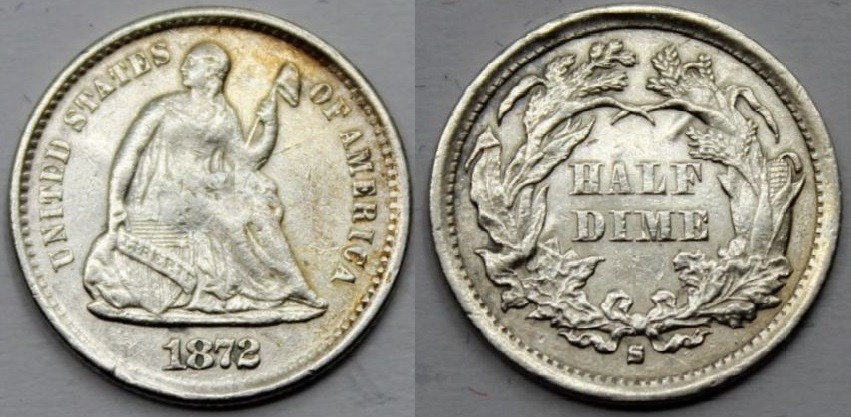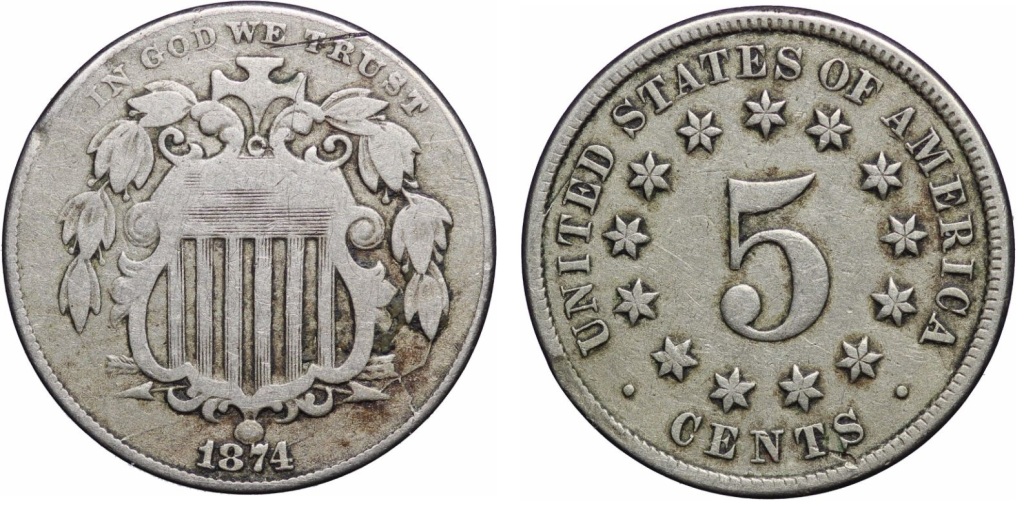 |
 |
| USA Coinage: 1869 - 1876 | ||||
| under President: Ulysses Simpson Grant | ||||
| Ulysses S. Grant, born Hiram Ulysses Grant (April 27, 1822 – July 23, 1885) was the Commanding General of the United States Army at the end of the American Civil War and later the 18th President of the United States from March 04, 1869 to March 04, 1877. As Commanding General, Grant worked closely with President Abraham Lincoln to lead the Union Army to victory over the Confederacy in the Civil War. Supported by Congress, Grant implemented Reconstruction, often at odds with President Andrew Johnson. Twice elected president, Grant led the Republicans in their effort to remove the vestiges of Confederate nationalism and slavery, protect African-American citizenship, and support economic prosperity. Although his presidency has often been criticized for multiple administration scandals and for his failure to alleviate the economic depression following the Panic of 1873, he is regarded as a President who performed relatively well in the context of his time and pursued justice for all. | ||||
| The Battle of Shiloh, also known as the Battle of Pittsburg Landing, was a major battle in the Western Theater of the American Civil War, fought April 6–7, 1862, in southwestern Tennessee. A Union force known as the Army of the Tennessee under Major General Ulysses S. Grant had moved via the Tennessee River deep into Tennessee and was encamped principally at Pittsburg Landing, Tennessee on the west bank of that river, where the Confederate Army of Mississippi, under General Albert Sidney Johnston and second-in-command P. G. T. Beauregard, launched a surprise attack on Grant's army from its base in Corinth, Mississippi. Johnston was mortally wounded during the fighting; Beauregard, who thus succeeded to command of the army, decided against pressing the attack late in the evening. Overnight Grant was reinforced by one of his own divisions stationed further north and was joined by three divisions from another Union army under Maj. Gen. Don Carlos Buell. This allowed them to launch an unexpected counterattack the next morning which completely reversed the Confederate gains of the previous day. | ||||
| On April 14, five days after Grant's victory at Appomattox, he attended a cabinet meeting in Washington. Lincoln invited him and his wife to Ford's Theater, but they declined as they had plans to travel to Philadelphia. In a conspiracy that targeted several government leaders, Lincoln was fatally shot by John Wilkes Booth at the theater, and died the next morning. Many, including Grant himself, thought that he had been a target in the plot. Stanton notified him of the President's death and summoned him back to Washington. Attending Lincoln's funeral on April 19, Grant stood alone and wept openly; he later said Lincoln was "the greatest man I have ever known." Regarding the new President, Andrew Johnson, Grant told Julia that he dreaded the change in administrations; he judged Johnson's attitude toward white southerners as one that would "make them unwilling citizens", and initially thought that with President Johnson, "Reconstruction has been set back no telling how far." | ||||
| Grant was popular among
the Radical Republicans following his abandonment of Johnson over the
Secretary of War dispute. The Republicans chose Grant as their presidential
candidate on the first ballot at the 1868 Republican National Convention in
Chicago. Grant received all 650 votes from delegates, with no other
candidate being nominated, and upon the announcement was welcomed with a
"frenzied enthusiasm". In his letter of acceptance, Grant concluded with
"Let us have peace", which became his campaign slogan. For vice president,
the delegates nominated House Speaker Schuyler Colfax Jr. The United States presidential election of 1868 was the 21st quadrennial presidential election, held on Tuesday, November 3, 1868. It was the first presidential election to take place after the American Civil War, during the period referred to as Reconstruction. As three of the former Confederate states (Texas, Mississippi, and Virginia) were not yet restored to the Union, their electors could not vote in the election. The incumbent President, Andrew Johnson, who succeeded to the presidency in 1865 following the assassination of President Abraham Lincoln, was unpopular and failed to receive the Democratic presidential nomination. By 1868, Johnson had alienated many of his constituents and had been impeached by Congress. Although Johnson kept his office, his presidency was crippled. After numerous ballots, the Democrats nominated former New York Governor Horatio Seymour to take on the Republican candidate, Civil War general Ulysses S. Grant. Grant was one of the most popular men in the North due to his efforts in concluding the Civil War successfully for the Union. Although Seymour was buried in the electoral college, he gave Grant a good race for the popular vote. |
||||
| The United States presidential election of 1872 was the 22nd quadrennial presidential election, held on Tuesday, November 5, 1872. The incumbent President Ulysses S. Grant was easily elected to a second term in office, with Senator Henry Wilson of Massachusetts as his running mate. Grant's decisive re-election was achieved in the face of a split within the Republican Party that resulted in a third party of Liberal Republicans nominating Horace Greeley to oppose Grant. This action caused the Democratic Party to cancel its convention, support Greeley as well, and not nominate a candidate of its own. On November 29, 1872, after the popular vote was counted, but before the Electoral College cast its votes, Greeley died. As a result, electors previously committed to Greeley voted for four different candidates for president and eight different candidates for vice-president. Greeley himself received three posthumous electoral votes, but these votes were disallowed by Congress. The election of 1872 is the only United States presidential election in which a major party nominee died during the electoral process. It was the last instance until the 2016 presidential election in which more than one presidential elector voted for a candidate to whom they were not pledged. Greeley was the new Liberal Republican Party's candidate in the 1872 U.S. presidential election. He lost in a landslide, despite having the additional support of the Democratic Party. He was devastated by the death of his wife, who died five days before the election, and died himself three weeks later, before the electoral college had met. | ||||
| After a year-long struggle with cancer, surrounded by his family, Grant died at 8 o'clock in the morning in the Mount McGregor cottage on July 23, 1885, at the age of 63. Sheridan, then Commanding General of the Army, ordered a day-long tribute to Grant on all military posts, and President Grover Cleveland ordered a thirty-day nationwide period of mourning. After private services, the honor guard placed Grant's body on a special funeral train, which traveled to West Point and New York City. A quarter of a million people viewed it in the two days before the funeral. Tens of thousands of men, many of them veterans from the Grand Army of the Republic marched with Grant's casket drawn by two dozen horses to Riverside Park in the Morningside Heights neighborhood of Upper Manhattan. His pallbearers included Union generals Sherman and Sheridan, Confederate generals Simon Bolivar Buckner and Joseph E. Johnston, Admiral David Dixon Porter, and Senator John A. Logan, the head of the GAR. Following the casket in the seven-mile-long procession were President Cleveland, the two living former presidents Hayes and Arthur, all of the President's Cabinet, as well as the justices of the Supreme Court. Grant's body was laid to rest in Riverside Park, first in a temporary tomb, and then - twelve years later, on April 17, 1897 - in the General Grant National Memorial, also known as "Grant's Tomb", the largest mausoleum in North America. Attendance at the New York funeral topped 1.5 million. Ceremonies were held in other major cities around the country, while Grant was eulogized in the press and likened to George Washington and Abraham Lincoln. | ||||
| Grant has appeared on the front of the United States fifty-dollar bill since 1913. In 1921, the Ulysses S. Grant Centenary Association was founded with the goal of coordinating special observances and erecting monuments in recognition of Grant's historical role. The venture was financed by the minting of 10,000 gold dollars and 250,000 half dollars. The coins were minted and issued in 1922, commemorating the 100th anniversary of Grant's birth. Grant has also appeared on several U.S. postage stamps, the first one issued in 1890, five years after his death. | ||||
| Currency: Dollar = 100 cents | ||||
| Monetary System: Penny = Cent, Trime = 3 Cents, Nickel = 5 Cents, Dime = 10 Cents, Quarter = 25 Cents, Half Dollar = 50, Cents, Dollar = 100 Cents, Quarter Eagle = $2.50 Gold, Stella = $4.00 Gold, Half Eagle = $5.00 Gold, Eagle = $10.00 Gold and Double Eagle = $20.00 Gold. | ||||
|
Mint Marks: C – Charlotte, N.C., 1838-1861. CC – Carson City, NV, 1870-1893. D – Dahlonega, GA, 1838-1861. D – Denver, CO, 1906-present. O – New Orleans, LA, 1838-1909. P – Philadelphia, PA, 1793-present (coins without mintmark also belongs to Philadelphia). S – San Francisco, CA, 1854-present. W – West Point, NY, 1984-present. |
||||
|
|
||||
| 1872 | ||||
|
||||
| 1874 | ||||
|
||||
View below links on
coins issued during the Presidential rulers of United States:
|
||||
| Countries / Territories | ||||
| Chiefa Coins | ||||

